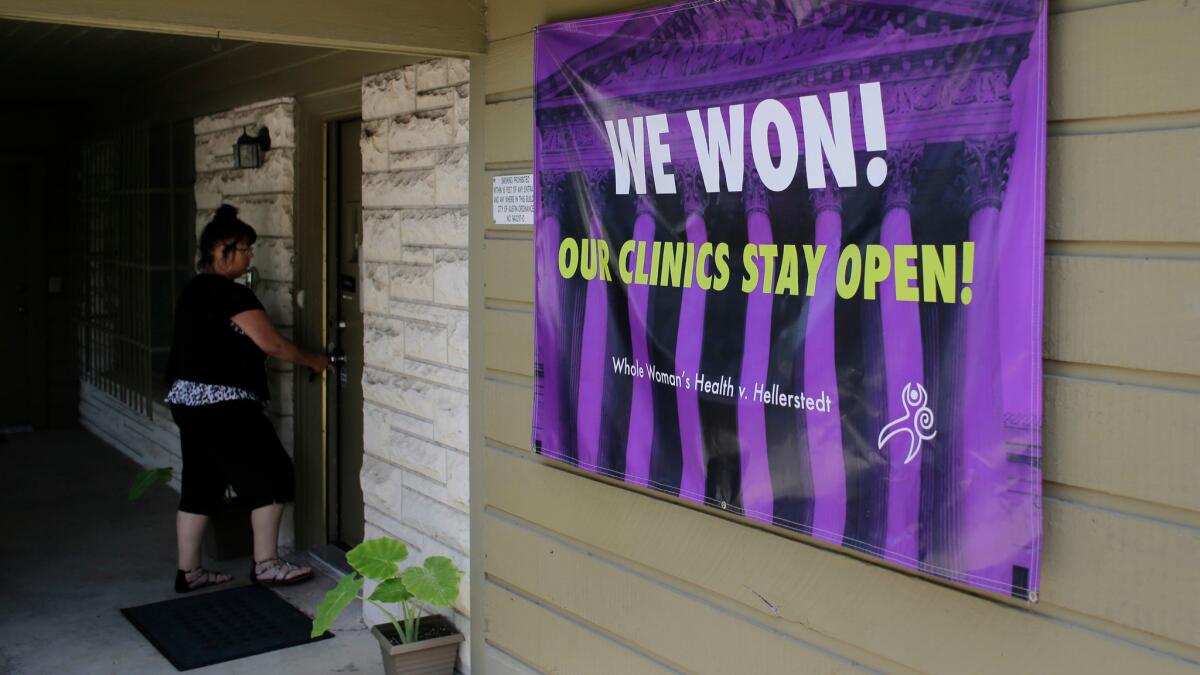Op-Ed: Abortion isnât an outlier medical procedure, itâs a constitutional right

In recent years, opponents of abortion rights have succeeded in making it much more difficult for women in large swathes of the United States to safely and legally terminate their pregnancies. They did so under the flimsy pretext of protecting womenâs health and safety, securing the enactment in state after state of onerous, cost-prohibitive and medically unnecessary restrictions designed to force clinic closures and otherwise impede abortion access.
On Monday, the Supreme Court responded to a prime example of the dishonest âhealth and safetyâ scam with a 5-3 decision striking down an alarmingly effective pair of restrictions in Texas. The courtâs ruling in Whole Womanâs Health vs. Hellerstedt, and the implicit reinforcement of the judiciaryâs essential role in safeguarding abortion rights, marks a turning point in the still-raging battle to preserve womenâs reproductive freedom, not just in Texas but nationwide.
One of the restrictions at issue mandated that all physicians performing abortions obtain admitting privileges at a nearby hospital, which typically are unattainable for political and bureaucratic reasons unrelated to a doctorâs competence. The second restriction singled out abortion providers for costly surgical center standards, revealingly not imposed on facilities performing other common procedures with much higher complication rates, such as colonoscopies and liposuction.
Together those restrictions threatened to leave the stateâs 5.4 million reproductive-age women with 10 or fewer abortion clinics, compared with around 40 before their enactment, and without any clinic in the more than 500-mile stretch between San Antonio and the New Mexico border â all on the basis of the false notion that abortion is a risky procedure requiring obstructive regulations.
âWe conclude that neither of those provisions offers medical benefits sufficient to justify the burdens upon access that each imposes,â wrote Justice Stephen Breyer in the majority opinion joined by Justices Anthony Kennedy, Ruth Bader Ginsburg, Sonia Sotomayor and Elena Kagan.
Before the justices was a wildly off-base ruling by a three-judge panel of the U.S. Court of Appeals for the Fifth Circuit. It upheld the stateâs restrictions, declining to seriously examine whether they imposed an âundue burdenâ on abortion rights, as called for under the Supreme Courtâs 1992 ruling in Planned Parenthood of Southeastern Pennsylvania v. Casey.
Access to abortion, as the Supreme Court reaffirmed on Monday, is a fundamental liberty. It’s not an outlier medical procedure, it’s a constitutional right.
The Fifth Circuit judges refused to acknowledge the strong medical consensus that neither of the challenged provisions actually advanced womenâs health. They further claimed that âany conceivable rationaleâ for the restrictions was sufficient â an ultra-deferential approach that amounts to judicial malpractice. For starters, it misses the critical role of courts in looking behind government explanations and checking legislative and executive overreach.
Breyer took pains to swat down the Fifth Circuitâs lame view. âThe rule announced in Casey⌠requires that courts consider the burdens a law imposes on abortion access together with the benefits the law imposes,â he wrote.
With that clarification, the court not only avoided the stealthy dismantling of abortion rights in Texas, but also added teeth to the undue burden standard. From here on out, anti-abortion activists will have to demonstrate that any proposed restrictions actually provide a benefit, one that justifies an imposition on a fundamental right. Since most if not all recent abortion laws do no such thing, pro-reproductive rights forces have a powerful new weapon.
At its heart, the case posed a profound test of the courtâs commitment to evidence-based judging. It may not be surprising, but itâs certainly sad that the courtâs conservative bloc, including Chief Justice John Roberts, refused to call out a rather obvious legislative hoax. They actually went so far as to dismiss the connection between the restrictions and the dramatic drop in open clinics, claiming there was insufficient evidence of a causal link. Such chutzpah would be laughable if the jurists werenât so powerful.
More than a third of American women have at least one abortion before the age of 45, most of them already mothers. Access to abortion, as the Supreme Court reaffirmed on Monday, is a fundamental liberty. Itâs not an outlier medical procedure, itâs a constitutional right that facilitates womenâs ability to participate equally in the countryâs economic and social life.
Dorothy Samuels, a former member of the New York Times Editorial Board, is a senior fellow at the Brennan Center of Justice at New York University School of Law.
Follow the Opinion section on Twitter @latimesopinion or Facebook
More to Read
A cure for the common opinion
Get thought-provoking perspectives with our weekly newsletter.
You may occasionally receive promotional content from the Los Angeles Times.










